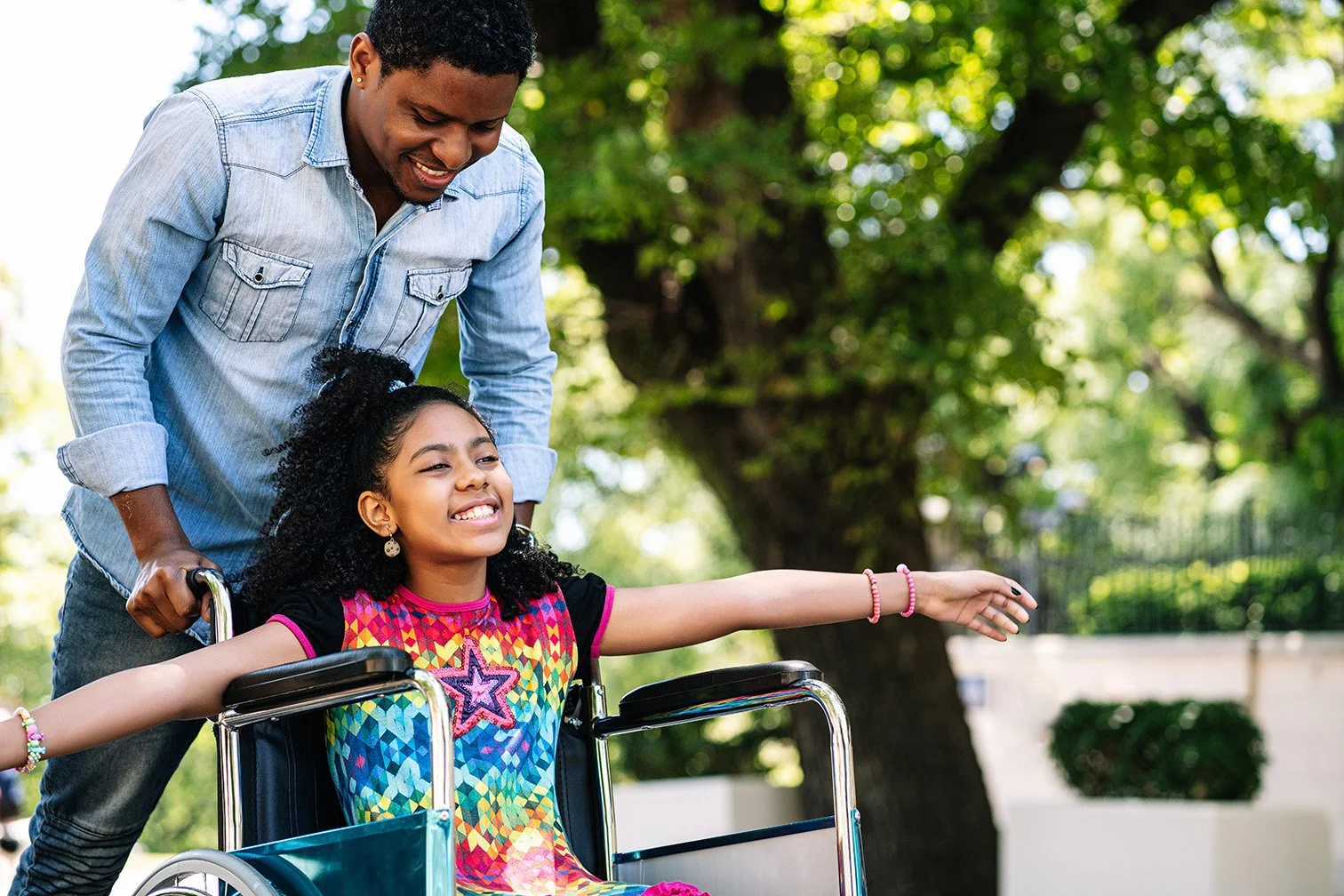As recently announced, the next phase of the CHILD-BRIGHT Network is being made possible thanks to a grant from the Canadian Institutes of Health Research (CIHR) under Canada’s Strategy for Patient-Oriented Research (SPOR), as well as matching funds from our generous partners. This support will allow us to grow from Network to Movement as we realize our mission for 2022-2026: moving our patient-oriented research into action through insight and methods grounded in implementation science and knowledge mobilization that embed the principles of equity, diversity, inclusion, decolonization and Indigenization.
In order to achieve this vision and become a movement for change for children and youth with brain-based developmental disabilities and their families, we have brought together experts from across Canada to lead our five patient-oriented programs.
Our Equity, Diversity, Inclusion, Decolonization and Indigenization (EDI-DI) Program will deploy initiatives to ensure that EDI-DI principles are authentically embedded in our four other programs and our governance structure. These efforts will be led by CHILD-BRIGHT’s Director of EDI-DI Nomazulu Dlamini.
Nomazulu Dlamini
CHILD-BRIGHT Director of EDI-DI
Staff Neurologist, Division of Neurology, SickKids
Associate Professor, Department of Paediatrics, University of Toronto
We sat down with Noma to learn more about the EDI-DI Program’s plans for Phase 2:
WHAT IS YOUR PROGRAM’S MANDATE?
Nomazulu Dlamini: Our EDI-DI Program looks to ensure all voices, bodies, and experiences are included in all aspects of our network’s work.
Our primary goal is to establish and maintain equitable, accessible, and inclusive research environments while advancing research excellence through health equity in patient-oriented research (POR) using an intersectional approach with other network collaborators across Canada.
We will ground the network’s activities in our EDI-DI framework. Our principal objectives for Phase 2 include increasing our representation of equity-deserving groups across our network such as patient-partners, trainees, researchers, and participants, as well as centering the voices of people with lived experience and Indigenous Ways of Knowing & Being. This is essential to address health inequities that persist within these communities. We will also build EDI-DI training capacity into patient-oriented research to impact patient-partner engagement, training, research design, implementation science (IS), and knowledge mobilization (KM).
HOW DO YOU PLAN TO ACCOMPLISH THIS? WHAT ARE THE MAIN TOOLS (CONCEPTS, FRAMEWORKS) THAT WILL BE USED TO FURTHER THIS MANDATE?
ND: In 2021, we developed our EDI-DI framework, which outlines our commitments to shifting the culture of the CHILD-BRIGHT Network and actively taking part in reflective practices throughout our engagement, research, and knowledge mobilization work. In Phase 2, we will integrate the EDI-DI framework, Indigenous Ways of Knowing & Being, and impacts of intersectionality in the conduct of research focused on all children with brain-based developmental disabilities, including children from historically marginalized communities.
In the early stages of Phase 2, we will form advisory committees to guide our work in Indigenous Health as well as in EDI and health equity. We will be intentional in hiring people with lived experiences and unique professional skills in EDI-DI, Indigenous health, and health equity in relation to POR, IS, and KM.
Working with our Training & Capacity Building Program, we will ensure the EDI-DI lens is at the forefront within the network’s activities and develop a certificate course on the application of EDI-DI. We have begun to develop a “learning pathway” that prioritizes core training and addresses learning gaps for the entire network.
HOW WILL YOUR PROGRAM MEANINGFULLY ENGAGE PATIENT-PARTNERS?
ND: One of our goals as a program is to ensure CHILD-BRIGHT diversifies its representation of equity-deserving groups such as patient-partners, trainees, researchers, and participants across our network. In Phase 2, we will collaborate with our Citizen Engagement team to create and build relationships with people and communities who are currently underrepresented in our network.
TELL US MORE ABOUT YOU. WHAT MOTIVATED YOU TO TAKE ON THIS LEADERSHIP ROLE WITH CHILD-BRIGHT?
ND: Reducing health disparities by improving allyship, agency, access and systems has always been a huge motivator for me. Through my research, I aim to understand the mechanisms of injury, repair and neuroplasticity of the developing brain following stroke. I’m highly committed to ensuring such advances in research translate in a clinically meaningful way and touch the lives of all individuals impacted, including those in marginalized communities, which is why I believe the work we’re doing in the CHILD-BRIGHT EDI-DI Program is so important. I’m highly engaged with patients and families and have taken on multiple EDI-DI leadership roles at SickKids and in the pediatric neurology and stroke research communities at the national and international levels. These activities have been rewarding and motivating.
My involvement with CHILD-BRIGHT began with the Stimulation for Perinatal Stroke Optimizing Recovery Trajectory (SPORT) research project, where I was a site Principal Investigator. Then, in 2020, I co-led a workshop for the network’s executive and central office teams called “Unlocking the Power of Allyship”, which was followed by a workshop on “Understanding and Unlearning Implicit Bias”, before I accepted the position of Director of EDI-DI.
WHY IS IT IMPORTANT TO FOCUS ON EDI-DI IN PATIENT-ORIENTED RESEARCH NOW?
ND: Indigenous Peoples, people with disabilities, racialized people, the LGBTQQIA2S+ (Lesbian, Gay, Bisexual, Transgender, Queer and/or Questioning, Intersex, Asexual, Two-Spirit, and other affirmative ways people choose to self-identify) community, and other equity-deserving groups continue to be confronted by the effects of colonialism, systemic racism, biases, and inequities in health care. We know that the effects of health disparities are magnified by the intersection of multiple oppressions, which also exist within research.
In order for our research to have its fullest impact possible, we need to address these inequities and reach those children, youth, and families who are most affected by the lack of social justice and health equity. We believe that patient-oriented research can offer a path towards ensuring equity by way of ongoing engagement with our patient-partners and Indigenous communities, including supportive and inclusive leadership, dedicated resources, accountability, and transparency.
WHAT ARE YOU MOST EXCITED TO SEE IN PHASE 2?
ND: I am excited to see the results of the culture shift we are undertaking. I hope that by creating both “safe” and “brave” spaces for us to learn from one another, we will increase our understanding of each other in a global community sense. This will provide a foundation for the substantial work that we are setting out to do and improve the impact of our patient-oriented research.
As one of the first steps towards this culture shift, many of our network members completed a four-part EDI-DI workshop this summer. I am already seeing signs of increased knowledge and personal growth. You can see “lightbulb moments” happening by observing people’s faces, their eyes, their tears, by listening to what is said and left unsaid. It’s all very telling and makes me hopeful for the journey we are all embarking on.
Thank you, Noma, for this insight into the EDI-DI Program!
If you are interested in learning more about the EDI-DI Program, please reach out to our EDI-DI Program Coordinator at edi-di@child-bright.ca.









